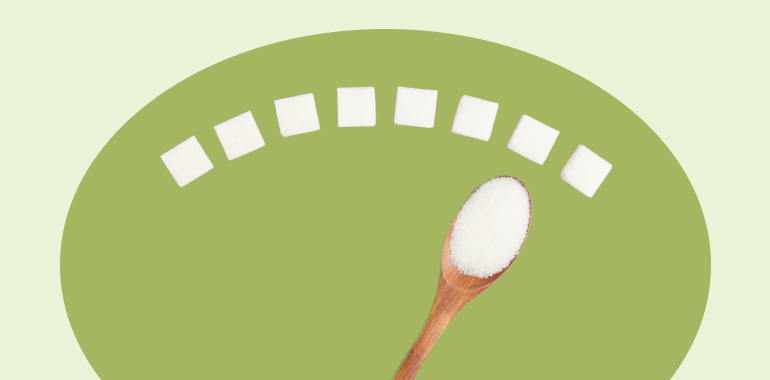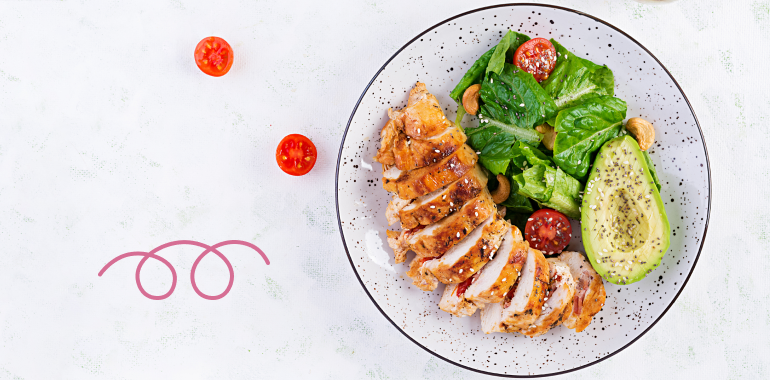Table Of Contents
What is a Keto Diet, and How Does it Affect Sugar Intake?
A ketogenic diet (or “keto” for short) is a high-fat, moderate protein, and very low-carbohydrate diet that has been shown to help people lose weight and improve specific health markers such as blood sugar control and cholesterol levels.
The goal of a keto diet is to enter a state of ketosis, where the body switches from using glucose (sugar) as its primary fuel source to using ketones, which are produced from fat when carbohydrate intake is limited.
Also, read – Low Carb Breakfast Without Eggs: Ideas & Advice
When following a keto diet, it is essential to consume a small amount of sugar on keto as much as possible, as sugar is a type of carbohydrate that can quickly raise blood sugar and insulin levels. This can make it difficult to achieve and maintain a state of ketosis. Instead, keto dieters often choose to sweeten their food and beverages with low-carbohydrate sweeteners like stevia, erythritol, or sucralose, which do not affect blood sugar levels.
In addition to limiting sugar intake, keto dieters also need to pay close attention to the number of carbohydrates in their diet, as even small amounts of carbs can cause blood sugar and insulin levels to rise, disrupting ketosis. This means avoiding high-carbohydrate foods like bread, pasta, rice, and sugar-laden desserts and instead focusing on low-carbohydrate, high-fat foods like meats, fish, nuts, seeds, and healthy oils.
This has the added benefit of reducing sugar intake because your body no longer needs it to function correctly. Not only does this reduce total calorie intake, but it sacrifices little in terms of flavor and texture, as keto-friendly recipes tap into healthy alternatives like olive oil, avocado oil, and nut butter instead of sugary ingredients common in traditional cooking.

Sugar on Keto: Daily Limits and Guidelines
Understanding keto how much sugar per day is acceptable forms the foundation of success on this diet. For the ketogenic diet to be effective, your daily carb intake should generally stay below 25-50 grams of net carbs. This tight restriction applies to all forms of carbohydrates, including sugar.
For most people following a strict keto diet, I recommend limiting sugar consumption to less than 10 grams daily. This minimal amount helps maintain ketosis while allowing some flexibility in your food choices. Remember that even natural sugars from fruits count toward your daily total.
The type of sugar you consume also matters. Natural sugars from low-carb berries or vegetables are preferable to refined sugar since they come packaged with fiber and nutrients. This fiber helps slow down sugar absorption, causing less dramatic blood glucose spikes.
If you’re just starting on keto, you might benefit from keeping a food journal to track your sugar intake. Many people are surprised to discover hidden sugars in processed foods like salad dressings, sauces, and even some meat products. Reading nutrition labels becomes an essential habit for staying within your daily sugar allowance.
As your body adapts to using ketones for fuel instead of glucose, you’ll likely notice your sweet cravings diminishing naturally. This makes following the recommended sugar limits on keto increasingly manageable over time.
Types of Sugar You Can Have on Keto
The keto diet requires precision with carbohydrate intake, but certain types of sugar can be included in small amounts. Understanding which sugars fit into your daily macros is crucial for maintaining ketosis while satisfying cravings.
Here are some types of sugar that can be consumed in small amounts on a keto diet:
- Natural sugars: Small amounts of natural sugars from whole foods like fruits and vegetables can be incorporated into a keto diet. However, choosing low-carbohydrate options, such as berries, avocados, and leafy greens, is vital.
- Artificial sweeteners: Low-carbohydrate sweeteners like stevia, erythritol, and monk fruit extract are commonly used in keto-friendly desserts, drinks, and snacks. These sweeteners do not raise blood sugar levels and are generally considered safe.
- Sugar alcohols: Sugar alcohols like xylitol, sorbitol, and maltitol are often used in low-carb products as a sugar substitute. While they are lower in carbs than regular sugar, they can still impact blood sugar levels and cause digestive issues in some people.
- Other sweeteners: Some sweeteners, like allulose, have recently become more popular in the low-carb and keto communities. Allulose is a low-calorie sweetener that does not raise blood sugar levels and can be used in small amounts.
When selecting sweeteners for your keto diet, consider both their glycemic impact and your personal tolerance. Some people find that even zero-calorie sweeteners can trigger cravings or stall weight loss. I’ve found that rotating different sweeteners can help prevent developing sensitivities or cravings associated with any single option.
Using moderate portion sizes can really help you on your journey if you choose to include sugar in your lifestyle!
Also, read – Keto vs Intermittent Fasting: What’s the Difference?
Is Sucralose Keto Friendly?
Yes, Sucralose is generally considered keto-friendly. Sucralose is a zero-calorie artificial sweetener that does not contain any carbohydrates or sugars, which means it does not affect blood sugar or insulin levels. This makes it a popular sweetener choice for people following a ketogenic diet or low-carb diet.
Sucralose is commonly used in many low-carb and keto-friendly products such as sugar-free gum, protein bars, and powdered drink mixes. However, it is essential to note that while sucralose is considered safe by many health organizations, some people may experience side effects such as digestive issues or headaches.
When purchasing products containing sucralose, check the ingredient list carefully. Some commercial sucralose products (like Splenda) contain dextrose or maltodextrin as bulking agents, which add small amounts of carbs that could affect your daily count. Pure liquid sucralose offers the sweetness without these additional carbs.
For baking on keto, sucralose can withstand high temperatures, making it more versatile than some natural sweeteners. I’ve successfully used it in everything from keto cheesecakes to cookies without any aftertaste issues that some other sweeteners produce.
As with any food or ingredient, it is recommended to consume sucralose in moderation as part of a balanced and varied diet.Daily Sugar Intake on Keto Sugar Amount Ketogenic Diet (Strict) Less than 20 grams per day Ketogenic Diet (Moderate) Less than 50 grams per day Ketogenic Diet (Liberal) Less than 100 grams per day
How Much Sugar Will Stop Ketosis?
The amount of sugar that will stop ketosis varies from person to person, depending on factors such as metabolic rate, activity level, and individual carbohydrate tolerance. This variability makes understanding your personal threshold essential.
Consuming more carbohydrates than your body can use for energy can lead to an increase in blood sugar levels, which triggers insulin release. Insulin helps move glucose out of the bloodstream and into cells for energy, but it also signals the body to stop producing ketones and shift back to using glucose as its primary fuel source.
- As a general rule, consuming more than 50 grams of net carbs per day is likely to significantly decrease the level of ketones in the blood and potentially stop ketosis, depending on the individual.
Some active individuals may maintain ketosis with slightly higher carb intake, while sedentary people might need to stay below 20 grams. I’ve found that using ketone testing strips or blood ketone meters can help determine your specific carbohydrate threshold through experimentation.
Another factor to consider is the timing of sugar consumption. Eating carbs after intense exercise, when your glycogen stores are depleted, may have less impact on ketosis than consuming the same amount when sedentary. This practice, sometimes called “targeted keto,” allows for strategic carb timing without fully exiting ketosis.
If you accidentally consume too much sugar and exit ketosis, don’t panic. Your body can typically return to ketosis within 24-48 hours of restricting carbs again, though this adjustment period may be accompanied by temporary fatigue or cravings.

Carbs in Common Sweeteners: What to Know
Understanding the carbohydrate content in different sweeteners is crucial for maintaining ketosis. Not all sweeteners affect blood sugar equally, and some may contain hidden carbs that could disrupt your ketogenic state.
Traditional table sugar contains approximately 4 grams of carbs per teaspoon, making it nearly impossible to include regularly on keto. Honey, while natural, contains about 17 grams of carbs per tablespoon, using up most people’s daily carb allowance in a single serving.
Here’s a quick reference for carb content in common sweeteners:
- Erythritol: 0g net carbs per teaspoon (contains 4g total carbs, but they’re not absorbed)
- Stevia: 0g net carbs per teaspoon
- Monk Fruit: 0g net carbs per teaspoon
- Xylitol: 0.4g net carbs per teaspoon
- Allulose: 0g net carbs per teaspoon
- Coconut sugar: 4g net carbs per teaspoon (not keto-friendly)
- Maple syrup: 13g net carbs per tablespoon (not keto-friendly)
When selecting sweeteners, consider both their glycemic index and their effect on insulin. Some sugar alcohols like maltitol, while marketed as low-carb, can still raise blood sugar significantly. I recommend opting for sweeteners with minimal glycemic impact, such as erythritol or stevia.
Many commercial “sugar-free” products contain multiple sweeteners for improved taste. Check labels carefully for hidden carbs or fillers like maltodextrin or dextrose, which can add unexpected carbs to your daily count.
How Many Carbs in a Tablespoon of Sugar?
A tablespoon of granulated white sugar typically contains about 12.5 grams of carbohydrates. This is equivalent to 1 tablespoon of any type of granulated sugar, such as white, brown, or raw sugar.
These simple sugars are quickly metabolized by the body, which raises blood sugar levels rapidly and can cause a spike in insulin if partaken in excess. Just one tablespoon of sugar represents over half the daily carb allowance for someone on a strict keto diet limited to 20g of carbs daily.
For perspective, that single tablespoon contains zero nutritional benefits beyond providing quick energy. I find it more satisfying to allocate those carbs to nutrient-dense foods like vegetables or small portions of berries, which provide fiber and essential vitamins alongside their carbohydrate content.
As part of a balanced lifestyle, informed decisions about sugar intake should be made; for example, using honey as a natural alternative to processed sugar is a way to reduce the number of overall carbs ingested without sacrificing taste or sweetness.
Also. read – Easy Keto Breakfast Ideas to Stay In Ketosis
The Role of Insulin in Blood Glucose Regulation on Keto
When it comes to achieving and maintaining optimal health on a keto diet, understanding the role of insulin in regulating blood glucose levels is essential. This vital hormone the pancreas produces helps transport glucose from the bloodstream into cells for energy and storage.
Insulin levels decrease on ketogenic diets due to lower carb intake, potentially improving metabolic health over time. With reduced insulin secretion, your body can more easily access stored fat for energy, which is the metabolic state that makes keto effective for weight management.
Caution about accidentally eating sugar on keto must be taken to avoid low insulin levels from leading to hypoglycemia. Therefore, monitoring both pre and post-meal glucose levels to ensure they are within an acceptable range is essential.
It’s important to note that consuming too much protein on a ketogenic diet can also increase blood glucose levels and insulin release. This is because excess protein can be converted into glucose through gluconeogenesis. I typically recommend keeping protein moderate—about 0.6-0.8 grams per pound of lean body mass—to prevent this conversion.
Furthermore, increasing fiber and nutrient-dense sources of healthy fats can support overall immune health as well as help balance out insulin production.
Therefore it’s vital to take an integrative approach towards optimizing your nutrition while following a keto diet, staying mindful of your glycemic control at all times. In addition, to maintain a state of ketosis and stable blood glucose levels on a ketogenic diet, it’s important to keep carbohydrate intake within the recommended range and monitor protein intake.
Can You Eat Sugar-Free Candy on Keto?
For individuals on the Keto diet, sugar-free candy can be a great snack choice. Whether or not you can eat sugar-free candy on a keto diet depends on the specific ingredients used in the candy. Many types of sugar-free candy contain artificial sweeteners, such as aspartame, sucralose, and erythritol, which can be keto-friendly.
While sugar-containing candy should always be avoided, many sugar-free candies contain low net carbs and significant amounts of healthy fats, making them excellent dietary options so long as they are consumed in moderation.
- Erythritol is a sugar alcohol commonly used in sugar-free candy and is often considered keto-friendly because it has a minimal impact on blood sugar levels and insulin response. However, it’s important to note that some people may experience digestive discomforts, such as gas or bloating when consuming large amounts of sugar alcohol.
- Other artificial sweeteners, such as aspartame and sucralose, are also considered low or no calories and have little to no impact on blood sugar levels. However, there is some debate about the potential health risks associated with the long-term consumption of these artificial sweeteners.
When shopping for sugar-free candy, I always check the nutrition facts panel for total and net carbs. Some sugar-free candies may still contain significant carbs from fillers or other ingredients. The best options typically contain fewer than 2 grams of net carbs per serving.
Consuming sugar-free candy in moderation and being mindful of overall carbohydrate intake is vital, as consuming too many carbohydrates, even from sugar-free sources, can hinder weight loss and ketosis.
In general, it’s best to choose whole, nutrient-dense foods on a ketogenic diet and to view sugar-free candy as an occasional treat.
Also, read – Are Eggs Keto? Plus, Other Foods
How Many Grams of Sugar Can You Have On Keto?
The specific amount of sugar you can have on keto diet varies depending on your personal goals and metabolic health. Generally, I recommend keeping your total added sugar intake below 5-10 grams daily to maintain optimal ketosis.
For those looking for rapid weight loss, a good starting point would be to limit daily sugar intake to 5-10 grams of natural sweeteners like stevia or erythritol and an occasional piece of fruit (which should be factored into your carb count).
Meanwhile, if maintenance is the main focus and the primary goal is health optimization, then slightly higher amounts of sugar, such as 25-50 grams per day, may be more appropriate. This approach, sometimes called “liberal keto,” provides more flexibility but may slow ketone production for some individuals.
Keep in mind that these numbers refer to total carbohydrates from all sources, not just added sugar. I’ve found tracking net carbs (total carbs minus fiber) to be more practical for most people, as fiber doesn’t significantly impact blood sugar or ketosis.
When calculating your sugar allowance, consider your activity level. More active individuals typically have greater carbohydrate tolerance without disrupting ketosis. If you exercise intensely, you might be able to include slightly more carbs without exiting ketosis.
Either way, paying attention to where your sugar comes from is essential; sticking with natural foods and avoiding products with unnecessary artificial ingredients and added sugars should always be prioritized.
Keto Sugar Alternatives: Best Sweeteners for Ketosis
The keto diet has a strict limit on natural sugars and carbohydrates, but this doesn’t mean that sweet treats are off the menu. Instead, creative cooks find alternatives to traditional sugar and add net carbs to their diets.
Many low-carb sweeteners on the market today make living a keto lifestyle still possible, even if you have a sweet tooth. Alternatives like stevia or monk fruit offer naturally zero-calorie substitutes for daily needs like baking and smoothies.
Some of the most popular keto-friendly sweeteners and alternatives include:
- Stevia:
A natural sweetener derived from the leaves of the stevia plant. Stevia has zero calories and zero carbohydrates and is commonly used as a sugar substitute.
- Erythritol:
A sugar alcohol that is often used as a low-carbohydrate sweetener. Erythritol has a zero glycemic index and is usually well-tolerated by most people.
- Xylitol:
Another sugar alcohol is commonly used as a sweetener. Xylitol has a glycemic index of 13 and may benefit dental health.
- Monk fruit extract:
A natural sweetener derived from monk fruit with zero calories and zero carbohydrates.
- Allulose:
A rare sugar that has a similar taste and texture to regular sugar but with fewer calories and a lower glycemic index.
When selecting sweeteners for keto, consider both taste preferences and your body’s individual response. I’ve found that combining sweeteners often creates the most sugar-like experience without the carbs. For example, a mixture of erythritol and monk fruit can closely mimic sugar’s taste and behavior in recipes.
These alternatives may not suit everyone, but they are essential to staying on track with your keto diet and avoiding too many restrictive feelings.
How to Track Sugar Intake While Maintaining Ketosis
Tracking sugar intake accurately is crucial for maintaining ketosis. I recommend using a dedicated food tracking app that shows both total and net carbs. These apps typically have extensive databases that include nutrition information for whole foods and branded products.
Begin by setting a daily carb limit that works for your body—typically 20-50g of net carbs for most people on keto. Within this limit, allocate a small portion for natural sugars if desired. Recording everything you eat, including condiments and beverages, ensures no hidden sugars slip through.
Reading food labels becomes an essential skill. Look beyond the “sugars” line to total carbohydrates, as all carbs can potentially affect ketosis. Pay special attention to ingredients like maltodextrin, dextrose, and modified food starch, which are carbohydrates in disguise.
Consider measuring ketone levels regularly to understand how your sugar intake affects your metabolic state. Options include urine strips (least accurate but inexpensive), breath analyzers, or blood ketone meters (most accurate). This feedback helps you adjust your sugar allowance based on your body’s actual response.
Meal planning also simplifies tracking. By planning meals in advance and calculating their carbohydrate content, you can allocate your daily sugar budget more effectively. I find that pre-logging meals in my tracking app before eating them helps prevent impulsive decisions that might exceed my sugar limit.
Managing Sugar Cravings on a Keto Diet
Sugar cravings can be one of the most challenging aspects of transitioning to a ketogenic diet. These cravings often peak during the first few weeks as your body adjusts to using fat instead of glucose for fuel. Understanding that these cravings are temporary and manageable can help you stick with your keto plan.
Here are effective strategies I’ve found for managing sugar cravings while maintaining ketosis:
- Increase healthy fat intake. Consuming adequate fat helps signal satiety to your brain and provides steady energy. Adding a tablespoon of MCT oil or coconut oil to your coffee or tea can quickly reduce cravings.
- Stay hydrated. Sometimes thirst masquerades as hunger or cravings. Drinking water with electrolytes can help manage the urge for sweets.
- Use keto-friendly sweet alternatives. Small amounts of stevia, monk fruit, or erythritol can satisfy a sweet tooth without disrupting ketosis.
- Include cinnamon in your diet. This spice naturally helps regulate blood sugar and can reduce cravings when added to beverages or keto-friendly foods.
- Create keto versions of favorite desserts using almond flour, coconut flour, and approved sweeteners to satisfy occasional treat cravings without breaking ketosis.
I’ve noticed that sugar cravings often indicate an electrolyte imbalance, particularly magnesium deficiency. Supplementing with magnesium glycinate before bed can help reduce sweet cravings while improving sleep quality.
Remember that taste preferences adapt over time. Foods that initially seem bland gradually become more flavorful as your palate adjusts to detecting natural sweetness in whole foods. Many long-term keto dieters report that previously enjoyed sugary foods eventually taste excessively sweet and unappetizing.
Small Amounts of Sugar on Keto: Tips for Success
In conclusion, it’s important to note that sugar has many potential negatives regarding the ketogenic diet. While it may be okay in small amounts, more significant amounts should generally be avoided.
The best way to approach this is by reading nutrition labels carefully and staying conscious of your added sugar intake. This way, you can ensure that the sugars and carbs you do consume are part of a well-rounded keto-friendly meal plan.
If you do choose to include small amounts of sugar on your keto journey, here are some practical tips for success:
- Time your sugar intake around physical activity when your body can use it most efficiently
- Pair sugars with healthy fats to slow absorption and minimize blood sugar spikes
- Choose naturally occurring sugars from whole foods over refined options
- Keep portion sizes small and measure accurately rather than estimating
- Monitor your ketone levels to see how different sugar sources affect your metabolism
I’ve found that implementing a “sugar budget” approach works well—allocating a small portion of your daily carb allowance specifically for treats can help prevent feeling deprived while maintaining metabolic flexibility.
Of course, like with any diet, minor tweaks and adjustments might need to be made as you go along, but having a solid understanding of how much sugar to have on keto will set any individual off on the right dietary path.
Rebecca is a nurse, yoga teacher, and freelance copywriter with a passion for holistic health and self-development. When she’s not working in the health sector, she enjoys hiking the outdoors, cooking, and traveling.










Thank you for the full information and the answer to the question how much sugar can you have on keto.
Hello, Liza 👋
Certainly! Happy to help with the info on sugar limits for keto.